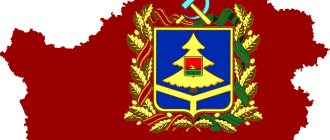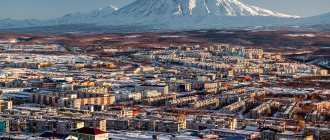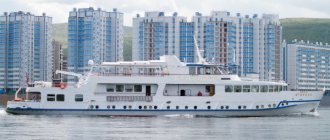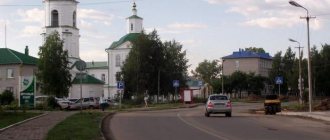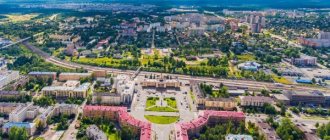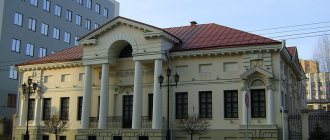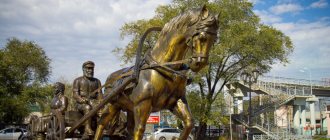City in Arkhangelsk Oblast, Russia
| Nyandoma Nyandoma | |
| City [1] | |
| Nyandoma railway station | |
| Coat of arms | |
| Location of Nyandoma | |
| Nyandoma Location of Nyandoma Show map of Russia Nyandoma Nyandoma (Arkhangelsk region) Show map of Arkhangelsk region | |
| Coordinates: 61°40'N 40°13'E / 61.667°N W. 40.217°E / 61.667; 40.217 Coordinates: 61°40'N 40°13'E. / 61.667°N W. 40.217°E / 61.667; 40.217 | |
| A country | Russia |
| Federal subject | Arkhangelsk region [1] |
| Administrative region | Nyandoma district [1] |
| City of district significance | Nyandoma [1] |
| Based | 1896 [2] |
| City status from | 1939 |
| Height | 220 m (720 ft) |
| population size (2010 Census) [3] | |
| • General | 22 356 |
| • Evaluate (2018) [4] | 19783 ( -11,5% ) |
| Administrative status | |
| • Capital from | Nyandoma district [1], city of district significance of Nyandoma [1] |
| Municipal status | |
| • Municipal district | Nyandoma municipal district [5] |
| • Urban village | Urban settlement Nyandoma [5] |
| • Capital from | Nyandoma municipal district [5], urban settlement Nyandomskoe [5] |
| Timezone | UTC+3 (MSK[6]) |
| Postal code [7] | 164200 |
| OKTMO ID | 11644101001 |
| Web site | nyandomamo.ru |
Nyandoma
(Russian: Nyandoma) is a city and the administrative center of Nyandoma District in Arkhangelsk Oblast, Russia, located 347 km (216 mi) south of Arkhangelsk, the administrative center of the region. Population: 22,356 people (according to the 2010 census); [3] 22,619 (2002 census); [8] 24,826 (1989 census). [9]
History[edit]
Nyandoma was founded in 1896 as a settlement in the area of the Nyandoma railway station on the newly built railway between Vologda and Arkhangelsk. [2] Railroad traffic was opened in 1898. [10] At that time, Nyandoma was part of the Kargopol district of the Olonets province. On July 15, 1929, the counties were abolished, the provinces became part of the Northern Territory, and the Nyandoma region was formed. It became part of the Nyandoma district, one of five in the Northern Territory. [11]Nyandoma served as the administrative center of the Nyandoma district. In 1930, the district was abolished, and the area was subordinated to the central administration of the Northern Territory. In 1936, the region was transformed into the Northern Region. In 1937, the Northern region was divided into Arkhangelsk and Vologda regions, and Nyandoma was transferred to the Arkhangelsk region. The village received city status in 1939 [ edit
]
Railway heritage
Nyandoma is located in the southwestern part of the Arkhangelsk region. The endless Nyandoma Upland stretches around. Its conventional borders are the Onega and Northern Dvina rivers. The glacier brought with it a huge amount of sand and clay and from this material built long ridges stretching from north to south. The heights here are small - up to 250 meters. This is the kingdom of the taiga.
Nyandoma is a station of the same name on the Konosha – Arkhangelsk railway line. The distance from Moscow is 790 km, from Arkhangelsk – 342 km. Since 2006, the settlement officially has the status of a regional center. It is curious that the entire city is divided into conventional districts, each of which has a “folk” name. There is “Vinegar Village”, “Tangshai”, “Fabrichny” and others.
The station building at Nyandoma station. 1913
The local climate is not particularly warm. Winter can last up to 250 days and is accompanied by winds and cold. The average temperature in winter fluctuates around -26 degrees, in summer – plus 15 degrees. Snow falls at the end of October and can remain until the beginning of May. The weather is prone to sudden changes. The greatest amount of precipitation falls in autumn. Real spring comes in April.
Administrative and municipal status[edit]
As part of its administrative divisions, Nyandoma serves as the administrative center of Nyandoma District. [1] As an administrative division, together with three rural settlements it is part of the Nyandoma district as the city of district significance of Nyandoma
.
[1] In the municipal formation, the city of district significance of Nyandoma, together with the territories of Andreevsky, Burachikhinsky and Shozhemsky village councils (which, respectively, include nine, five and one rural settlements, a total of fifteen rural settlements) in the Nyandoma district are part of the Nyandoma municipal district as urban settlement Nyandomaskoye
. [5]
Etymology of the city of Nyandoma
As for the name Nyandoma itself, it is not known for sure, but there are assumptions:
- The city got its name Nyandoma from a river of the same name flowing nearby.
- In Finno-Ugric the word "Nyandoma" means "rich land";
- In Sami “Nyammdeyavr” are glued lakes;
- In Karelian “Myandama” means “pine area”.
The inhabitants of this city are unofficially called “mamons”, where this name came from is also unknown, but there are also assumptions:
- Perhaps the Nyandoma people were nicknamed mamons, putting a certain meaning into this nickname, regardless of Savva Mamontov.
- A word from A.K. Matveev, professor at Ural University: “The nickname “mamons” means “gluttons.”
Economics [edit]
Industry[edit]
The timber industry is the most developed industry in the region. The food industry is also present, represented, in particular, by broiler farming. [10]
Transport[edit]
Nyandoma is located on an asphalt road connecting Dolmatovo with Kargopol. This road also provides access to one of Russia's main highways, the M8, connecting Moscow and Arkhangelsk. Another paved road in a southerly direction connects Nyandoma with Konosha.
Nyandoma is also located on the railway line between Moscow and Arkhangelsk (built in a south-north direction).
Attractions in Nyandoma
The Church of Saints Zosima and Savvaty of Solovetsky is an Orthodox church made of wood, built in 1902, which was plundered during Soviet times, and only in 2000 began to function again.
The monument to the soldiers who died during the Great Patriotic War was erected in 1977. The stela and sculpture of a soldier remind people of their fellow countrymen who died defending their Motherland.
The EM-723-37 steam locomotive is a wartime locomotive. The monument was erected near the old station in 1989.
Climate[edit]
| Climate data for Nyandoma | |||||||||||||
| Month | Jan | Feb | Mar | Apr | May | Jun | Jul | Aug | Sep | October | But I | December | Year |
| Daily average °C (°F) | −13 (9) | −12 (10) | −6 (21) | 1 (34) | 8 (46) | 14 (57) | 16 (61) | 14 (57) | 8 (46) | 1 (34) | −5 (23) | −10 (14) | 1 (34) |
| Source: Weatherbase [13] | |||||||||||||
Adventures from our tourist club in this direction
22.08 – 27.08 |
6 days Onega adventures
New Year in Kenozerye (ski)
Along the Onega River on packrafts (reconnaissance)
Links[edit]
Notes[edit]
- ^ abcdefgh State Committee of the Russian Federation on Statistics. Committee of the Russian Federation for Standardization, Metrology and Certification. No. OK 019-95 January 1, 1997 “All-Russian classifier of objects of administrative-territorial division. Code 11 244", ed. changes No. 278 / 2015 dated January 1, 2016. (Goskomstat of the Russian Federation. Committee of the Russian Federation for Standardization, Metrology and Certification. No. OK 019-95 January 1, 1997. Russian classification of administrative divisions) (OKATO).
Code 11 244 , as amended by Amendment No. 278/2015 of January 1, 2016). - ^ ab Encyclopedia of Russian Cities
. Moscow: Great Russian Encyclopedia. 2003. p. 322 ISBN. 5-7107-7399-9. - ^ a b Federal State Statistics Service (2011). “All-Russian Population Census 2010. Volume 1" [All-Russian Population Census 2010, vol. 1]. All-Russian Population Census 2010 [All-Russian Population Census 2010]
. Federal State Statistics Service. - "26. The size of the permanent population of the Russian Federation by municipalities as of January 1, 2022". Federal State Statistics Service. Retrieved January 23, 2022.
- ^ a b c d e Law No. 258-extra-OZ
- "On the Calculation of Time". Official Internet portal of legal information
. June 3, 2011. Retrieved January 19, 2022. - Post office. Information and computing center of OASU RPO. ( Post office
).
Search for postal service objects ( postal Search for objects
) (in Russian) - ↑
Federal State Statistics Service of Russia (May 21, 2004).
“The population of Russia, the constituent entities of the Russian Federation as part of federal districts, urban settlements, settlements, settlements of 3 thousand or more people” [Population of Russia, its federal districts, federal districts, districts, urban settlements, rural settlements - administrative centers and rural settlements with a population of more than 3,000 people] (XLS). All-Russian Population Census 2002
. - “All-Union Population Census of 1989. The current population of union and autonomous republics, autonomous regions and districts, territories, negative phenomena, urban settlements and rural district centers” [All-Union Population Census of 1989: current population of union and autonomous republics, Autonomous regions and districts , territories, regions, districts, towns and villages performing the functions of district administrative centers. All-Union Population Census of 1989 [All-Union Population Census of 1989]
.
Institute of Demography of the National Research University: Higher School of Economics [Institute of Demography of the National Research University: Higher School of Economics]. 1989 - via Demoscope Weekly
. - ^ a b Nyandoma (in Russian). www.arhangelskobl.ru. Retrieved July 2, 2011.
- “Archival copy” Resolution of the Presidium of the All-Russian Central Executive Committee of July 15, 1929 on the composition of the districts and communications of the Northern Territory and their centers (in Russian). consultant.ru. Archived from the original on January 4, 2016. Retrieved June 12, 2011.CS1 maint: archived copy as title (link)
- Nyandoma Museum "Nyan's House" (in Russian). Russian Cultural Heritage Network. Retrieved July 2, 2011.
- "Weather Base: Historical Weather for Nyandoma". Retrieved September 24, 2013.
Section 3. Location, climate and fauna of the area
The territory where the city of Nyandoma was built just over 100 years ago does not indulge its residents with favorable climatic conditions. The average temperature in winter is -17°C, and in summer the thermometer very rarely rises above +16°C. By the way, natural anomalies are also inherent in this area. Scientists studying the climate of this region claim that over the past 50 years, the maximum temperature recorded here was +32°C, the minimum -41°C. At the same time, precipitation falls quite often. In the warm season and in the off-season there is rain, in winter there is heavy snowfall.
The fauna of the area, especially considering where the city of Nyandoma is located, is very diverse, although it is still recommended to divide it into two categories: wild and urban fauna. In the vicinity of the settlement you can easily see brown bears, foxes, moose, squirrels, beavers, and wolves. But within the city limits there is a huge variety of birds, among which the most common are crows, sparrows, bullfinches and pigeons.
Section 5. Pages of local history
In the place where Nyandoma is located now, for quite a long time there were prerequisites for the construction of a comfortable settlement. Why? The railway, which was actively under construction, was in dire need of a permanent and reliable transport hub. This is how the station was built, which at that time was considered temporary. Gradually, dugouts and temporary huts of various designs began to be built around it.
Initially, in order for even a medium-sized settlement to arise in these parts, it was necessary to cut down the forest. This problem was partially solved during the construction of the railway; later the workers themselves cleared the areas that were uninhabited at that time. By the autumn of 1839, the laying of the rails was completed, after which local residents immediately began building the station itself and the church.
The progress didn't stop there. And literally 10 years later, the Arkhangelsk region as a whole, and the city of Nyandoma in particular, were transformed. The telegraph appeared first, and a little later the telephone. And in the settlement itself there is an inn, a school, sewing workshops, taverns, bakeries, bakeries and even a pub. Public transport in Nyandoma has been operating since 1960, and its number is increasing noticeably from year to year.
Even in difficult years for Russia, the city not only did not lose its identity, but also continued to develop. Now industry has improved, new schools and kindergartens have appeared and continue to be built, which means that the number of the local population is not decreasing from year to year.
Section 6. City coat of arms
If you think about where the city of Nyandoma is located, the photo of the coat of arms seems quite logical. Three pine trees of different sizes, symbolizing the almost untouched centuries-old nature of the region, and a black wheel with silver edges, as if once again reminding us that this is still a railway city, and the wheel has always been an emblem of movement and development in Rus'.

